Huskemaw 5-20 LR Scope Review
By Ernie Bishop
I remember my first thoughts when I heard about this new Huskemaw 5-20 LR Rifle scope being on the market. One of my first questions was, "What does it have to offer that other scopes on the market don't already have?" I guess in some ways I am a skeptic when it comes to the latest and greatest product whether it be concerning long range hunting or some other arena. To let the cat out of the bag, I can honestly say I was pleasantly surprised.
For those of you who do not know much about me, understand I use and own a number of other brand name long range optics with a variety of reticles. In other words, I am not stuck on one brand of scope. I am sure that the heated discussions over what is the best scope for long range hunting will continue. My goal in this review is not to tell you which long range hunting scope is the best, but to share my findings on the Huskemaw scope.
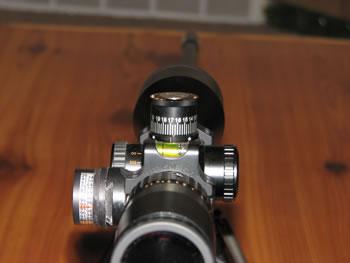
So, with that in mind, let's get to the business of reviewing a scope which is now a part of my collection for long range hunting. When I first opened the box for this review, the first thing I noticed was the size of the Huskemaw scope; it is relatively short for a long range optic of its kind, only 13.7 inches. For comparison's sake, the Leupold VX-3 6.5-20x50mm LRT is 14.4 inches long, and the Nightforce NXS 5.5-22x50mm is 15.1 inches, respectively. The objective lens of the Huskemaw scope is a 50 mm and it weighs 23 ounces. The Huskemaw has a 30 mm tube, which is consistent with most of the upper level long range hunting optics today. Weight is 23 ounces compared to 20.4 ounces for the Leupold scope, and 31 ounces for the Nightforce scope mentioned above. I use the optics for comparison purposes, since one or both will be familiar to those reading this review.
I took the Huskemaw scope outside and looked through it for awhile, messing around with magnification and parallax adjustments like all good hunters do or should do. Then, I went inside and did something that evening I had never done before. I read the instructions! It is not like I never read the instructions, but after so many scopes, you glance at it, and it is basically the same for all practical purposes. What caught my attention about the Huskemaw scope's instructions is that it was more like a booklet (more than 20 pages) than your typical scope owner's manual. I never thought I would ever make a comment like this about an optic, but Huskemaw's owner manual is the most impressive that I have ever looked at. I am not saying it is best because it has more pages, but because it is the most thorough I have ever looked at. A DVD is included with the instruction guide. With both of these tools, it will allow a beginner to understand Huskemaw's new scope and its features to the point of making first shot connections at long range.
The information that Huskemaw has given is informational, easy to understand, and practical. You may be thinking to yourself, "Get on with the review of the scope and quit talking about an owner's manual." For those of you who have been shooting at long range for a period of time successfully may not need this kind of information. I receive regular correspondence from those who are thinking about getting into the game or have recently started. The information presented in the Huskemaw manual and DVD would answer many of their questions. I even had Aaron Davidson from Best of the West send me an extra manual and DVD for that very purpose for some of my friends who live in this area who are considering a long range scope.
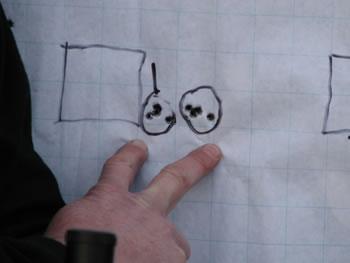
My first time out with the Huskemaw 5-20 LRH Scope was back in April when longtime hunting buddy, Steve Hugel, came up for a couple of days. First, we went to the local range and did some load development for a rear-grip XP-100 @ 200 yards on paper. I was using four-shot groups, and two of the groups were in the .4 inch range and the other was in the .5 inch range. I am always pleased when I shoot ½ inch or better at 200 yards. Then we went out of town and put steel up at 546 yards, 730 yards, and 799 yards. There were two 11" circular steel plates at the closer distances and a 10" x 20" rectangular plate at 799 yards. All shooting at these distances was from the prone position.
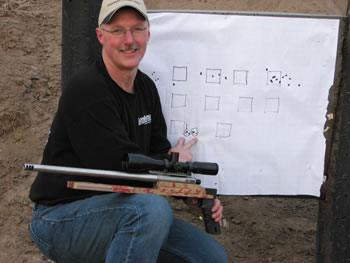
On this date and at times since then, the Huskemaw scope tracked perfectly on two different Remington XP-100's and an MOA Maximum handgun. On the first day in the field, I had a nice 4-shot group that was in the 4" range at 730 yards with a 5th shot taking me to a 9"-10" group. The wind caught me on the fifth shot - Oh well! By the time we moved out to 799 yards, the wind decided to give lessons in humility, with some incredible updrafts that the spotters were able to see via vapor trails. It wasn't the scope's fault that I didn't have good groups; I completely missed the target a couple of times. Even with an accurate rig, great optics, and spotters, you can still be put in your place quickly due to gusty winds that are switching back and forth. Do I trust the reliability of the Huskemaw scope's turret system and its ability to hold zero? Yes!
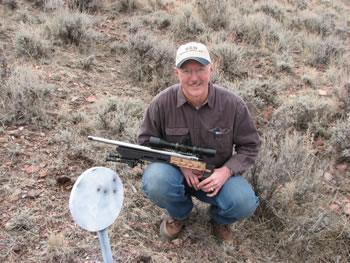
On another day I was able to go to a different rancher's place to compare scopes (Leupold's new VX-3 8.5-25 LRT, Nightforce NXS 5-22, Sightron S-3 6-24, and the Huskemaw 5-20). I had a friend with me on this day as well. I don't claim to be a scope expert, but here is my experience which was echoed by others who compared these scopes on this day as well as on a few others. Since the Huskemaw scope had the lowest upper magnification, we set all of the other scopes' magnification on 20x. When looking at antelope from 1,000-1,200 yards from mid-day to late afternoon, the Huskemaw scope was on par with the Nightforce and the Leupold scopes. The Sightron scope took a noticeable last place. The color contrast on the antelope was noticeably better with the Huskemaw scope versus the Sightron. I have used the Sightron for long range prairie dogging past 1,000 yards successfully and have used it in a 3-day long range competition, but optically it does not stand up to the Huskemaw scope in these areas. When looking at a structure at 45 minutes past sunset, all four of the scopes did well. With that being said, I expect some will disagree with my findings, as we all have our favorites. I admit that some of my results were surprising even to me, but that is my findings with these four scopes. More than anything, I am pleased to see that another well thought out, high quality long range hunting scope is available for sportsmen.
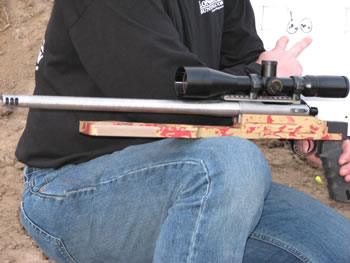
Another debate that can be quite polarizing among long-range shooters is dialing versus using ballistic reticle, MOA reticle, or Mil-Radian reticle. Those who dial will divide over whether to use a turret that is listed in MOA or Mil-Radians versus a BDC (Bullet Drop Compensator) turret cap. The Huskemaw scope is designed for those who want to dial the yardage and can use the reticle or dial for doping the wind.
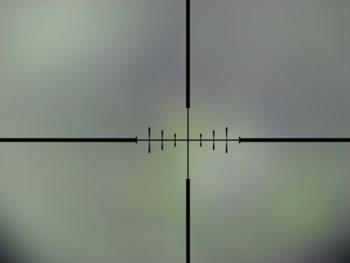
The yardage and the MOA wind correction for a 10 mph crosswind (at 20x if using the reticle), is listed on the turret. Once you have done your homework and filled out the Manual Data Sheet and send it to Huskemaw Optics in Cody, WY, you will soon have your own RFBC. Now, you determine range to target, check wind, dial the distance, hold off for wind on the reticle and shoot.
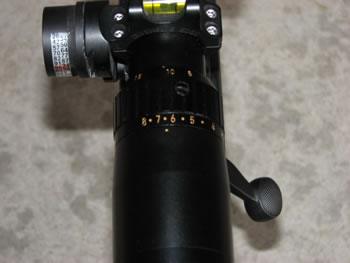
By Ernie Bishop
I remember my first thoughts when I heard about this new Huskemaw 5-20 LR Rifle scope being on the market. One of my first questions was, "What does it have to offer that other scopes on the market don't already have?" I guess in some ways I am a skeptic when it comes to the latest and greatest product whether it be concerning long range hunting or some other arena. To let the cat out of the bag, I can honestly say I was pleasantly surprised.
For those of you who do not know much about me, understand I use and own a number of other brand name long range optics with a variety of reticles. In other words, I am not stuck on one brand of scope. I am sure that the heated discussions over what is the best scope for long range hunting will continue. My goal in this review is not to tell you which long range hunting scope is the best, but to share my findings on the Huskemaw scope.
I have hunted 4 seasons using the Huskemaw scopes. I like the optical quality, the custom yardage turrets. I also like the smaller dimensions and weight compared to what I was using. Sure I make money by promoting my sales of them. But believe me, using a really good scope on my hunts is way, way more important to me than making a few bucks selling scopes. And this one is VERY good.
-- Len Backus, Publisher of LRH

So, with that in mind, let's get to the business of reviewing a scope which is now a part of my collection for long range hunting. When I first opened the box for this review, the first thing I noticed was the size of the Huskemaw scope; it is relatively short for a long range optic of its kind, only 13.7 inches. For comparison's sake, the Leupold VX-3 6.5-20x50mm LRT is 14.4 inches long, and the Nightforce NXS 5.5-22x50mm is 15.1 inches, respectively. The objective lens of the Huskemaw scope is a 50 mm and it weighs 23 ounces. The Huskemaw has a 30 mm tube, which is consistent with most of the upper level long range hunting optics today. Weight is 23 ounces compared to 20.4 ounces for the Leupold scope, and 31 ounces for the Nightforce scope mentioned above. I use the optics for comparison purposes, since one or both will be familiar to those reading this review.
I took the Huskemaw scope outside and looked through it for awhile, messing around with magnification and parallax adjustments like all good hunters do or should do. Then, I went inside and did something that evening I had never done before. I read the instructions! It is not like I never read the instructions, but after so many scopes, you glance at it, and it is basically the same for all practical purposes. What caught my attention about the Huskemaw scope's instructions is that it was more like a booklet (more than 20 pages) than your typical scope owner's manual. I never thought I would ever make a comment like this about an optic, but Huskemaw's owner manual is the most impressive that I have ever looked at. I am not saying it is best because it has more pages, but because it is the most thorough I have ever looked at. A DVD is included with the instruction guide. With both of these tools, it will allow a beginner to understand Huskemaw's new scope and its features to the point of making first shot connections at long range.
The information that Huskemaw has given is informational, easy to understand, and practical. You may be thinking to yourself, "Get on with the review of the scope and quit talking about an owner's manual." For those of you who have been shooting at long range for a period of time successfully may not need this kind of information. I receive regular correspondence from those who are thinking about getting into the game or have recently started. The information presented in the Huskemaw manual and DVD would answer many of their questions. I even had Aaron Davidson from Best of the West send me an extra manual and DVD for that very purpose for some of my friends who live in this area who are considering a long range scope.

My first time out with the Huskemaw 5-20 LRH Scope was back in April when longtime hunting buddy, Steve Hugel, came up for a couple of days. First, we went to the local range and did some load development for a rear-grip XP-100 @ 200 yards on paper. I was using four-shot groups, and two of the groups were in the .4 inch range and the other was in the .5 inch range. I am always pleased when I shoot ½ inch or better at 200 yards. Then we went out of town and put steel up at 546 yards, 730 yards, and 799 yards. There were two 11" circular steel plates at the closer distances and a 10" x 20" rectangular plate at 799 yards. All shooting at these distances was from the prone position.

On this date and at times since then, the Huskemaw scope tracked perfectly on two different Remington XP-100's and an MOA Maximum handgun. On the first day in the field, I had a nice 4-shot group that was in the 4" range at 730 yards with a 5th shot taking me to a 9"-10" group. The wind caught me on the fifth shot - Oh well! By the time we moved out to 799 yards, the wind decided to give lessons in humility, with some incredible updrafts that the spotters were able to see via vapor trails. It wasn't the scope's fault that I didn't have good groups; I completely missed the target a couple of times. Even with an accurate rig, great optics, and spotters, you can still be put in your place quickly due to gusty winds that are switching back and forth. Do I trust the reliability of the Huskemaw scope's turret system and its ability to hold zero? Yes!

On another day I was able to go to a different rancher's place to compare scopes (Leupold's new VX-3 8.5-25 LRT, Nightforce NXS 5-22, Sightron S-3 6-24, and the Huskemaw 5-20). I had a friend with me on this day as well. I don't claim to be a scope expert, but here is my experience which was echoed by others who compared these scopes on this day as well as on a few others. Since the Huskemaw scope had the lowest upper magnification, we set all of the other scopes' magnification on 20x. When looking at antelope from 1,000-1,200 yards from mid-day to late afternoon, the Huskemaw scope was on par with the Nightforce and the Leupold scopes. The Sightron scope took a noticeable last place. The color contrast on the antelope was noticeably better with the Huskemaw scope versus the Sightron. I have used the Sightron for long range prairie dogging past 1,000 yards successfully and have used it in a 3-day long range competition, but optically it does not stand up to the Huskemaw scope in these areas. When looking at a structure at 45 minutes past sunset, all four of the scopes did well. With that being said, I expect some will disagree with my findings, as we all have our favorites. I admit that some of my results were surprising even to me, but that is my findings with these four scopes. More than anything, I am pleased to see that another well thought out, high quality long range hunting scope is available for sportsmen.

Another debate that can be quite polarizing among long-range shooters is dialing versus using ballistic reticle, MOA reticle, or Mil-Radian reticle. Those who dial will divide over whether to use a turret that is listed in MOA or Mil-Radians versus a BDC (Bullet Drop Compensator) turret cap. The Huskemaw scope is designed for those who want to dial the yardage and can use the reticle or dial for doping the wind.

The yardage and the MOA wind correction for a 10 mph crosswind (at 20x if using the reticle), is listed on the turret. Once you have done your homework and filled out the Manual Data Sheet and send it to Huskemaw Optics in Cody, WY, you will soon have your own RFBC. Now, you determine range to target, check wind, dial the distance, hold off for wind on the reticle and shoot.

You can buy a Huskemaw scope at the LRH Store

